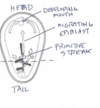Embryology: Germ Layers Flashcards
Label the following image

a. Zygoye
b. fertilized egg
c. Cleavage
d. Morula
e. Blasttula Embryoblast
f. 2 layer embryo

How many weeks after ferlization foes the cell become the blastula/embyoblast? when does the 2 layer embryo form?
- Week 1
- Week 2
when does gastrulation occur?
week 3

what major events happen during this phase of embrology?

Folding, migration, growth, differentiation

Label the diagram

a. coelom
b. yolk sac
c. somatic LPM
d. Nerve tube
e. notochord
f. coelom

Label the diagram of the Bilaminar Germ Disc

- Bilaminar Germ Disc
- Developing Mouth
- Primitive Streak
- Epiblast
- Hypoblast

The epiblast cells migrate through the __________ to form which germ layers
- Primitive Streak
- to form all 3 germ layers (ectoderm, mesoderm, endoderm)
Label this diagram of gastrulation (3 layer embryo)

- Developing Mouth
- Migrating Epiblast
- Primitive Streak

Is this step gastrulation or neurolation?

gastrulation
no notochord formation
Label this diagraph of neurulation

a. Notochord induces neural folds
b. head
c. tail
d. primitive node
e. primitive streak

Label the following diagram

- Neural Folds
- Future Neural Crest
- Future neural tube

the surface ectoderm becomes the _______
skin
At the end of neuralation ______folding start forming
lateral
label the following diagram

- paraxial mesoderm
- intermediate mesoderm
- somatic laterial mesoderm (L.P.M)
- Splanchnic L.P.M
- Cardiac Tubes
- Notochord Acial Mesoderm
- Coelom

______becomes the surface epithelium and neural tissue
Ectoderm
______becomes the epithelium
endoderm








